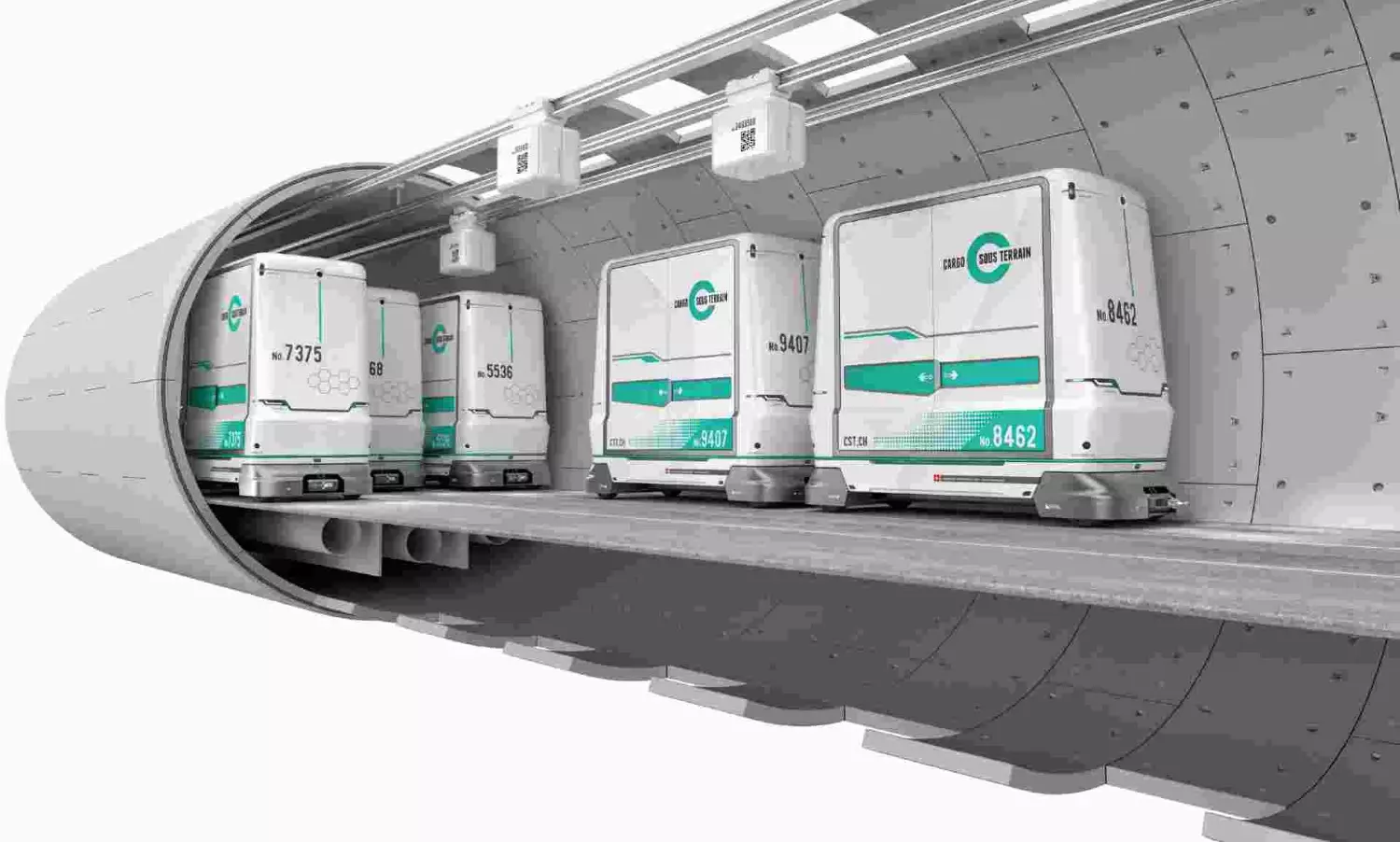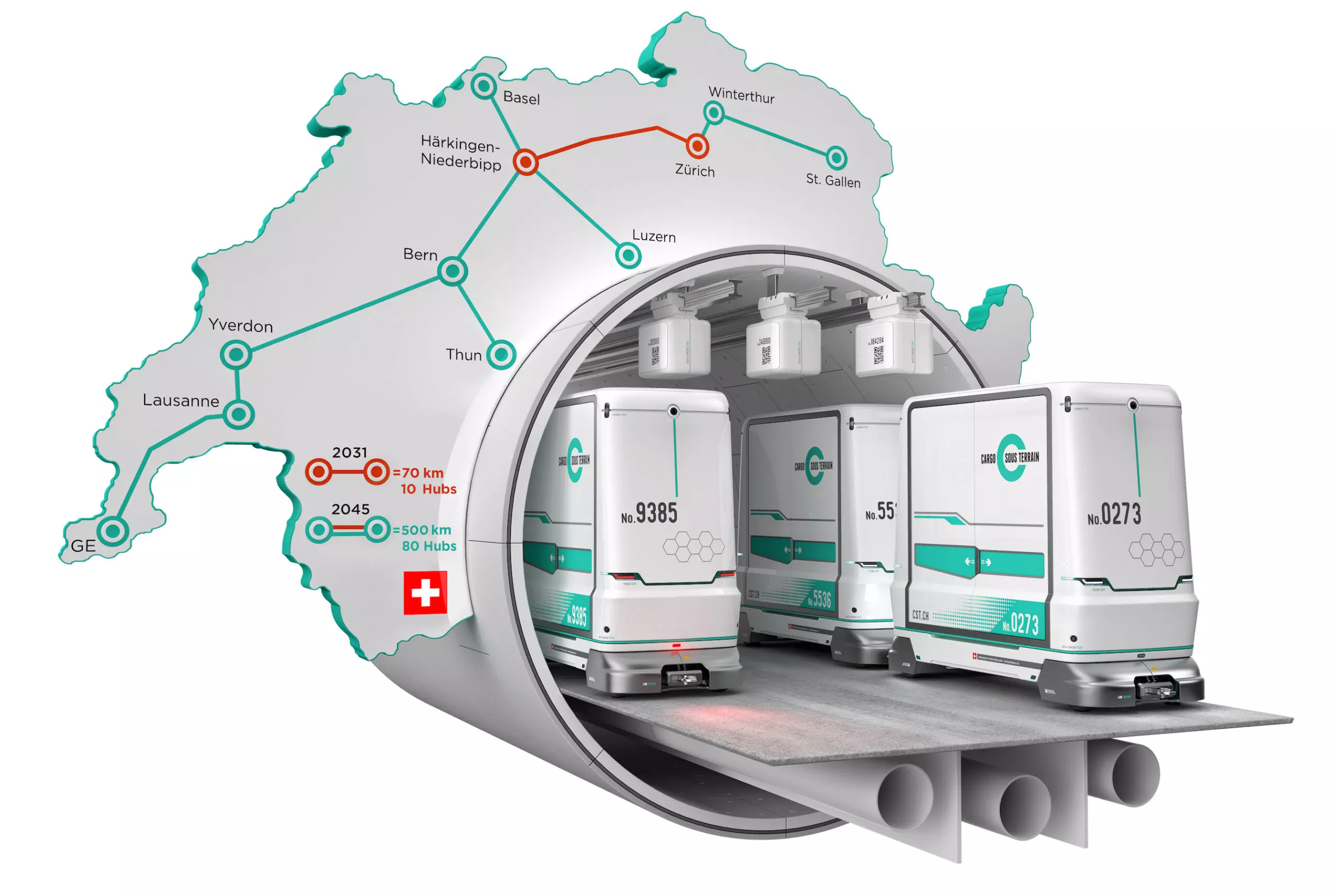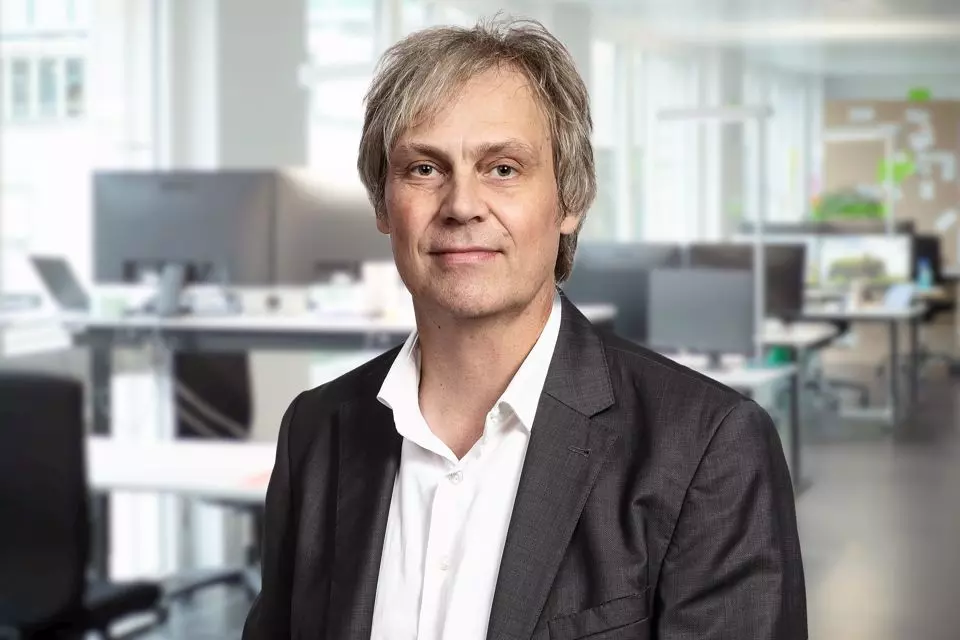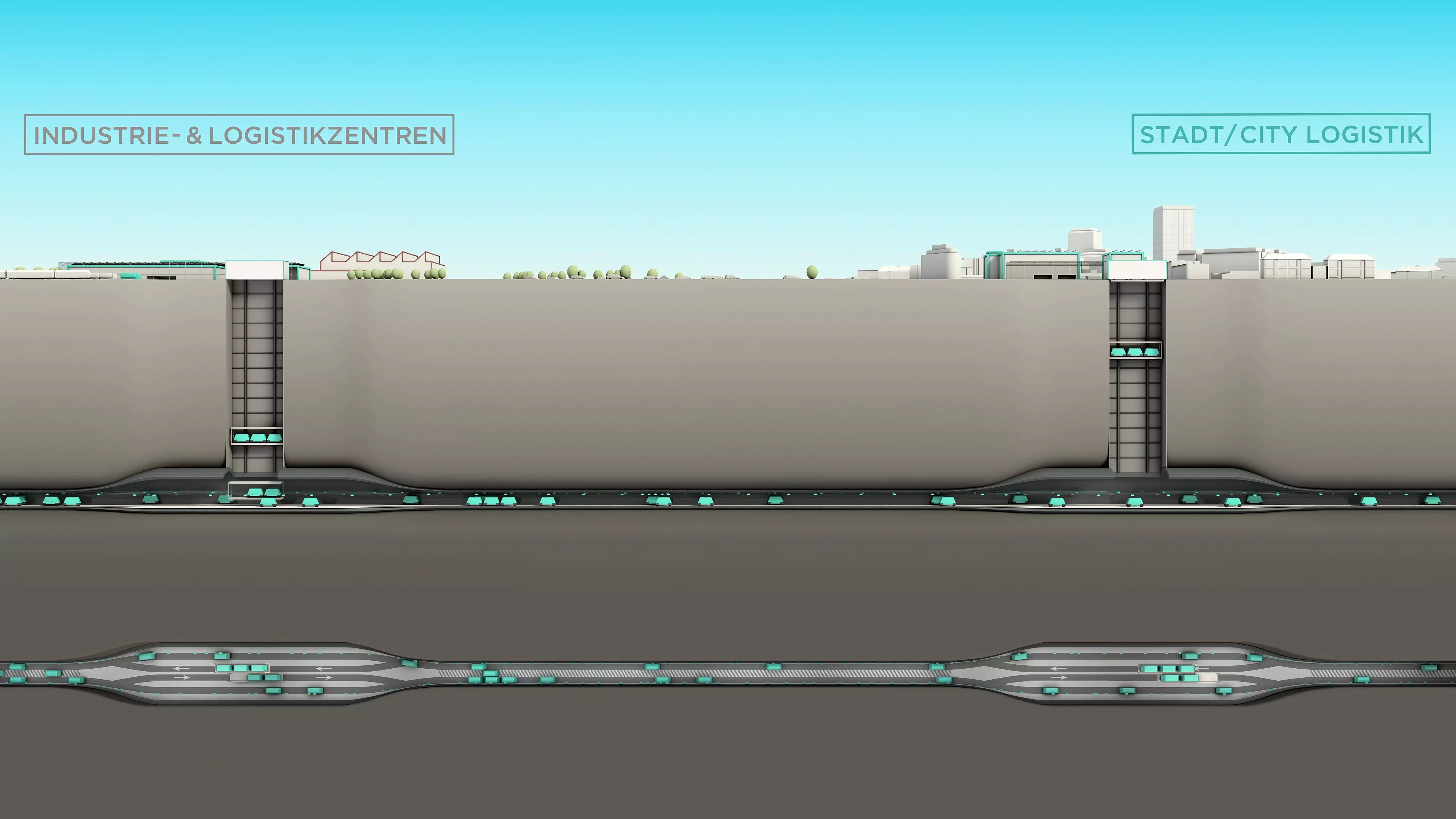Switzerland to get its first autonomous underground cargo delivery system
A continuous flow of goods will be transported on a pallet that can handle medium-sized packages such as food and small furniture, as well as a pallet carrying smaller packages from the tunnel's roof.

Switzerland is preparing to make headlines in 2031 with the Cargo Sous Terrain (CST) automated underground cargo system, which will connect Switzerland's major hubs. CST aspires to relieve pressure on road and rail networks, decrease environmental impact, and assure timely delivery of products to everyone.
A continuous flow of goods will be transported on a pallet that can handle medium-sized packages such as food and small furniture, as well as a pallet carrying smaller packages from the tunnel's roof.
Zinal Dedhia of Logistics Update Africa spoke with Patrik Aelling, Head of Communications, Cargo Sous Terrain, to understand more about the cargo transportation system plan, investor interest, and the benefits of such cargo and package delivery system.
Tell me about underground autonomous cargo delivery.
A group of people in Switzerland came up with the idea. On the one hand, engineers provided the technological solution, while business people stated that we must ensure that our supply chains remain operational in the future and develop a sustainable solution for cargo transportation.
That's when engineers got together with consumers and system users, and, of course, you needed some form of funding to get this thing started. And, certainly, funding is something that is rather easy to obtain in Switzerland.
We've come a long way and demonstrated that the system is feasible from a technological, legislative, and geological standpoint. With a competent business strategy and sufficient finance, we demonstrated that the market is indeed ready for a solution like this. We've moved ahead one step at a time, and yes, we're getting closer. I mean, it's still 10 years away, but we're making fantastic progress.
In which region of Switzerland will the first autonomous underground cargo delivery system deploy? You aim to begin operations in 2031, at what stage are you currently for this project?
CST's project will be implemented in the north of the Alps, which covers around 80% of the country's population, and this will be the whole region of Switzerland that will connect major cities from west to east to north and to the Alps' southern boundary.
We are now building the first leg of this entire network, which will connect Zurich to the main logistics centre in a little town named Härkingen-Niederbipp, a distance of around 70 kilometres.

We have come a long way in this planning stage; we know where the tunnel will be built and where the hubs or connecting points will be located. So we're in the middle of this planning stage, which will take another two or three years until we have a firm basis to begin building in 2025 or 2026.
Can you explain the importance of sustainability with the project?
One of the primary goals in establishing the system was to ensure its sustainability. From an environmental aspect, the main idea was that we needed to create an area that could free up space above ground since infrastructures were reaching their capacity. We can't create roads; we can't even build railroads as much as we'd like due to space constraints. The main objective of the system was to provide a more dependable transit, not necessarily a faster mode of transport.
By developing this new underground infrastructure, you would alleviate several difficulties such as traffic congestion and road closures. To power our system, we will only use sustainable energy sources, mostly electricity. As a result, we created each system component in the most sustainable way possible. We also made sure, by having professionals conduct a life cycle assessment, that every tonne of goods transported with our system will be transported in a more sustainable way than any other mode of transportation, including electric lorries and train transport, and that we will be the most sustainable system on the market once we open in 2031.
What kind of products will you be carrying? What will be the capacity?
Anything that fits on a pallet. This might include food, small furnishings, and digital products, and we will also have special containers for transporting refrigerated goods. It's practically anything with the appropriate proportions.
You may return recyclable things in the same system after delivery, therefore we'll utilise it for that as well. The only item that isn't allowed is really dangerous components such as explosives because they require a completely different security system than what we have.
Will this be a middle-mile service? What are the prices of each cargo range?
We were more interested in middle mile service when we created a system since we had the notion of these large logistical hubs. But we soon realised that this would not be sufficient because if we only deliver to the outskirts of the city and leave the items, the consumers would not be able to utilise it; they would have to handle the last mile delivery themselves.
As a result, we introduced last-mile deliveries from these logistical hubs. We incorporated it into our operations. That will happen overground in cities, with last-mile delivery provided by appropriate vehicles driven by renewable energy.
How beneficial will this system be for small parcels when compared to deliveries by drones?
Yes, this underground infrastructure will be useful, but drone capacity is limited. Consider the same number of commodities that we can move through a 70-kilometre tunnel with three lanes, and then consider it airborne by drones. All of the systems that are being designed for the future will have to work together. And, I believe there will always be room for the right solution in the right situation. However, we will never be the exclusive mode of transporting goods; you will always have access to overland transportation as well. And that is what defines a sustainable future when all of these components come together and each can use its unique capabilities.
How challenging was it to get regulatory approvals?
These processes that involve the government are usually slow in Switzerland because of the many levels of participation. The advantage is that once anything is developed, it has a solid foundation. So we understood it would take time. We were not taken seriously for some time when others questioned us or said, "The idea of an underground cargo system may be visionary, but would you ever be able to materialise anything like this?"

Patrik Aelling, Head of Communications, Cargo Sous Terrain
The government then imposed a variety of requirements, such as seeking clearance from the regional level where we planned to create this system. We also had to show that we could get the 100 million in Swiss francs. We accomplish it by having signed binding letters of intent signed by all of these companies that, if we reach a certain level, they would come up with this 100 million Swiss francs. People then began to take us seriously because of these investments.
Do you have investors? Who is funding the project? How much investment have you received?
CST has over 70 companies investing in it. But, of course, there is a range from very small to expert companies wishing to be a part of the system that own just two or three shares up to large ones. As of today, we have acquired 100 million Swiss francs. That is roughly the same amount of money that we have so far, allowing us to fully enter this planning phase. To complete the plan we will need 3 billion Swiss francs to build this first leg, which is a significant amount.
The further we progress, the more realistic we become, and the simpler it is to attract new investors. And right now, we're putting together the money, to understand how we can make this financing work for 3 billion Swiss francs. I must say that we are also making good progress in terms of system planning and development. So far, everything is going as planned.
What level of sophistication do you have for your digital infrastructure, given that the entire system will most likely be fully operated and controlled digitally? What are your ideas on the investment, research, and attention you will put into this?
Digitization is an important part of the system. We will invest hundreds of millions of Swiss francs in developing the digital platform over the next few years. One significant advantage of CST is that we have multiple corporations as investors that are generally competitors. Different retailers collaborate for CST, but also logistics companies that are one-way competitors who collaborate to develop this platform, and I believe that this presents a huge opportunity for us to truly create a platform where different providers can bring in their services, both through the tunnel and through the digital infrastructure. I believe it has the potential to grow into a digital marketplace where various suppliers may even establish entirely new services. It will be exciting to see where we are headed with the development of this digital platform.

In the long run, how will this help in balancing demand and supply?
I believe the most important step will be to develop this system. It also needs some visionary thinking, some courage, and some investment. I believe that if we can demonstrate that this is feasible, it will have to serve as a model for many other initiatives. Other underground transportation projects exist across the world, the most renowned of which is the Hyperloop, which began with an emphasis on passenger transportation.
Of course, what you can accomplish underground is not completely limitless, but I believe it is a step we need to take not just when talking about logistics and cargo movement, but also when growing our services in our cities. So that everything is at the right level, some things are underground, some are on the surface, and some are also above ground. I believe it can play a vital role in the building of future sustainable smart cities.
Will you build the cargo containers and refrigerators yourself, or have you partnered with another company?
With all of the technology components, we are looking at what is now available on the market. It is possible that we will collaborate with a company that is developing exactly what we require. But I can assure you that we are always open to collaborations. We are not trying for exclusivity; rather, we are aiming for inclusion. Being inclusive is at the foundation of the system.


